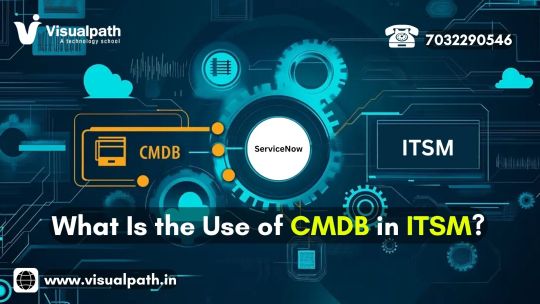Don't wanna be here? Send us removal request.
Text
Best ServiceNow Course | ServiceNow Training in Hyderabad
What Is the Use of CMDB in ITSM?
A Configuration Management Database (CMDB) plays a pivotal role in IT Service Management (ITSM) by acting as a centralized repository that stores detailed information about the configuration items (CIs) in an IT environment. These items include servers, applications, network devices, databases, software licenses, documentation, and more. The CMDB not only stores information about the assets themselves but also tracks their relationships and dependencies.

At its core, the CMDB enables organizations to understand how different components of their IT infrastructure interact and support business services. This visibility is crucial for maintaining stability, minimizing disruptions, and making informed decisions. ServiceNow Training
Key Functions and Benefits of CMDB in ITSM
1. Enhanced Incident and Problem Management
When a service interruption occurs, a CMDB allows IT teams to quickly identify the affected assets and their relationships. By knowing which systems are interconnected, root cause analysis becomes faster and more accurate. This reduces the mean time to resolve (MTTR) and helps prevent recurring issues.
2. Streamlined Change Management
Change is inevitable in IT, but uncontrolled change can lead to disruptions. CMDB supports change management by providing impact analysis. Before making a change, IT teams can evaluate which assets will be affected, what dependencies exist, and what risks are involved. This leads to better planning, fewer failed changes, and more successful deployments.
3. Accurate Configuration Audits and Compliance
Maintaining compliance with regulations such as GDPR, HIPAA, or SOX requires knowing what assets are in use and how they’re configured. The CMDB allows organizations to perform audits and prove that controls are in place. It also ensures configurations meet internal and external policies. ServiceNow Online Training
4. Improved Asset Lifecycle Management
CMDB tracks asset lifecycles from procurement to retirement. By knowing what hardware or software is nearing end-of-life, organizations can plan upgrades or replacements proactively. This reduces risks related to obsolete technologies and ensures budget planning is accurate.
5. Service Impact Analysis
In ITSM, services are built upon many technical components. If one component fails, the impact might be far-reaching. With a CMDB, service mapping is possible, making it easier to assess how outages affect business services. This is vital for prioritizing resolution efforts and informing stakeholders. ServiceNow Online Course
6. Better Decision Making
Having a single source of truth enhances decision-making at every level—from technical support to CIOs. Whether it's budget forecasting, resource allocation, or strategic planning, the insights from a well-maintained CMDB support data-driven choices.
Challenges in Maintaining a CMDB
While the benefits are clear, implementing and maintaining a CMDB is not without challenges. Common pitfalls include poor data quality, lack of integration with other tools, and insufficient processes for updating records. Automated discovery tools and integration with ITSM platforms like ServiceNow, BMC Remedy, or Ivanti can greatly improve data accuracy and reduce manual overhead. ServiceNow Course Online
Conclusion
The CMDB is a foundational element of ITSM that supports nearly every core ITIL process. It enables transparency, reduces downtime, enhances service quality, and ensures that IT services align with business needs. Organizations that invest in building and maintaining a strong CMDB position themselves to deliver more reliable, efficient, and strategic IT services. As IT environments become more dynamic, the role of the CMDB will only become more critical.
Trending Courses: Docker and Kubernetes, SAP Ariba, Site Reliability Engineering
Visualpath is the Best Software Online Training Institute in Hyderabad. Avail is complete worldwide. You will get the best course at an affordable cost. For More Information about ServiceNow Online Training
Contact Call/WhatsApp: +91-7032290546
Visit: https://www.visualpath.in/servicenow-online-training.html
#ServiceNowTraining#ServiceNowOnlineTraining#ServiceNowCourseOnline#ServiceNowTraininginHyderabad#ServiceNowTraininginAmeerpet#ServiceNowOnlineTrainingInHyderabad#ServiceNowInstituteinAmeerpet#ServiceNowInstituteinBangalore#ServiceNowInstituteinChennai#ServiceNowCourseinIndia#ServiceNowOnlineCourseinAmeerpet
0 notes
Text

VisualPath, a leading institute, offers expert ServiceNow training in Bangalore with real-time projects and hands-on experience. Our ServiceNow course in India provides 24/7 access, daily class recordings, and personalized mentorship for effective learning. You can benefit from resume-building support and global job opportunities through our career-focused curriculum. Call +91-7032290546 to join a free demo and advance your ServiceNow skills today!
Visit: https://www.visualpath.in/servicenow-online-training.html
WhatsApp: https://wa.me/c/917032290546Visit Our Blog: https://visualpathblogs.com/category/service-now/
#ServiceNowTraining#ServiceNowOnlineTraining#ServiceNowCourseOnline#ServiceNowTraininginHyderabad#ServiceNowTraininginAmeerpet#ServiceNowOnlineTrainingInHyderabad#ServiceNowInstituteinAmeerpet#ServiceNowInstituteinBangalore#ServiceNowInstituteinChennai#ServiceNowCourseinIndia#ServiceNowOnlineCourseinAmeerpet
0 notes
Text
ServiceNow Training | ServiceNow Course Online Training
Improving Form Load Time in ServiceNow
ServiceNow is a powerful platform for IT service management, used by organizations worldwide to streamline their service delivery. One critical aspect of enhancing the user experience on ServiceNow is improving form load times. Slow-loading forms can impact user productivity, frustrate end users, and reduce overall efficiency. This article discusses several techniques that can be employed to improve form load time in ServiceNow while ensuring the platform remains user-friendly and efficient.

1. Optimize Client Scripts and UI Policies
Client scripts and UI policies are vital components of ServiceNow forms. However, excessive use of these scripts can significantly impact form load time. One of the most effective ways to improve form performance is to reduce the complexity and number of client scripts executed during form load. ServiceNow Online Course
Use Efficient Client Scripts: Ensure that client scripts are optimized by limiting unnecessary operations. Use event-driven scripts rather than loading scripts for every form field. Avoid using the onLoad script for tasks that can be handled more efficiently elsewhere.
Avoid Synchronous Operations: Synchronous operations can lock the browser and delay form loading. Opt for asynchronous methods wherever possible to improve performance.
Minimize UI Policies: UI policies are another area that can slow down form loading. Review the UI policies to ensure that they are necessary, and disable any policies that are not actively in use. Additionally, try to keep the conditions and scripts within the policies as simple as possible to avoid overburdening the system.
2. Optimize Form Design
A well-structured form is not only easier for users to navigate but also more efficient in terms of performance. ServiceNow allows administrators to design forms with various fields and components, but overloading forms with too many elements can lead to longer load times.
Simplify Forms: Avoid creating forms with a large number of fields. Group related fields together and leverage tabbed or accordion sections to divide the form into manageable sections. This not only improves load time but also enhances the overall user experience.
Use Field Types Appropriately: Some field types require more resources than others. For instance, using reference fields and choice lists with a large number of options can slow down form loading. Limit the use of such fields unless necessary, or consider implementing auto-complete or search features to optimize their performance.
3. Implement GlideAjax for Server-Side Operations
ServiceNow offers GlideAjax, a powerful mechanism for running server-side logic without compromising form load performance. Using GlideAjax allows for the separation of client-side and server-side operations, reducing the load on the client’s browser.
Use GlideAjax for Data Retrieval: Instead of querying large datasets on form load, use GlideAjax to fetch data only when needed. This reduces the initial load time and improves form performance. Server-side logic can be offloaded to the server, with only the necessary data being passed to the client asynchronously.
Improve Data Handling: Avoid loading large datasets or unnecessary records when the form is loaded. If the form needs data from related records, consider using GlideRecord with proper filters to minimize the amount of data retrieved from the database. ServiceNow Training
4. Use Caching for Reusable Data
Data caching is an excellent method to reduce the time spent querying databases for frequently accessed information. ServiceNow supports caching, which can significantly improve form load times when the data being accessed does not change frequently.
Cache Frequently Used Data: Implement caching mechanisms for commonly accessed reference data or large datasets that do not change often. This reduces the need to repeatedly fetch the same data from the database, improving the overall performance of forms.
Configure Cache Duration: Be mindful of cache duration settings. Too short a duration could lead to unnecessary database queries, while too long could result in outdated information being presented to users. Strike the right balance for optimal performance.
5. Optimize Background Scripts and Scheduled Jobs
Background scripts and scheduled jobs are powerful tools in ServiceNow for automating tasks, but poorly optimized scripts can have a significant impact on form load time. If these tasks run during the form load process, they can delay the user experience.
Schedule Scripts Appropriately: Ensure that background scripts and scheduled jobs are executed during off-peak hours or when users are least likely to be affected. This ensures that tasks such as data aggregation or calculations do not interfere with form performance. ServiceNow Online Training
Optimize Scripts for Efficiency: Review background scripts to ensure that they are not overly complex or running unnecessary operations. Make use of appropriate indexing and filtering to minimize the time spent processing large datasets.
6. Limit the Use of Business Rules
Business rules are essential for automating tasks in ServiceNow, but poorly optimized business rules can slow down form load times. Business rules that run on form load or data updates can impact performance if they are too complex or involve a large number of records.
Optimize Business Rules: Review business rules to ensure that they are designed to trigger only when necessary. Avoid running business rules on form load if they are not required, and instead, run them on specific actions like form submission or record updates.
Use Server-Side Processing: Whenever possible, move processing logic from client-side scripts to server-side business rules. This offloads the burden from the browser and ensures that the client-side experience remains responsive.
7. Enable Load Balancing and Auto-Scaling
ServiceNow is a cloud-based platform, and its performance can be affected by server load and resource availability. Enabling load balancing and auto-scaling features can help distribute traffic more evenly across the servers, reducing the strain on any single server and improving overall performance.
Load Balancing: Configure load balancing to ensure that incoming traffic is distributed efficiently across multiple servers. This helps in maintaining consistent performance, especially during peak usage periods.
Auto-Scaling: Auto-scaling allows the system to automatically adjust resources based on demand. This ensures that the platform can handle increased traffic without affecting form load times.
8. Monitor and Analyze Performance
Finally, it is essential to continuously monitor and analyze the performance of ServiceNow forms. Use tools like Performance Analytics and Application Performance Management (APM) to track form load times and identify bottlenecks. ServiceNow Course Online
Performance Monitoring: Set up performance monitoring dashboards to track form load times and identify any issues that might be causing delays. Pay attention to server response times, script execution times, and database query performance.
Identify Bottlenecks: Use performance analysis tools to pinpoint areas where performance can be improved. This could include optimizing client scripts, reducing the complexity of forms, or addressing issues with database queries.
Conclusion
Improving form load time in ServiceNow requires a combination of best practices, including optimizing client scripts, designing efficient forms, utilizing server-side processing, and leveraging caching mechanisms. By adopting these techniques and continuously monitoring performance, organizations can enhance the user experience, improve productivity, and ensure that ServiceNow operates at peak efficiency.
Trending Courses: Docker and Kubernetes, SAP Ariba, Site Reliability Engineering
Visualpath is the Best Software Online Training Institute in Hyderabad. Avail is complete worldwide. You will get the best course at an affordable cost. For More Information about ServiceNow Online Training
Contact Call/WhatsApp: +91-7032290546
Visit: https://www.visualpath.in/servicenow-online-training.html
#ServiceNowTraining#ServiceNowOnlineTraining#ServiceNowCourseOnline#ServiceNowTraininginHyderabad#ServiceNowTraininginAmeerpet#ServiceNowOnlineTrainingInHyderabad#ServiceNowInstituteinAmeerpet#ServiceNowInstituteinBangalore#ServiceNowInstituteinChennai#ServiceNowCourseinIndia#ServiceNowOnlineCourseinAmeerpet
0 notes
Text
ServiceNow Course in India | ServiceNow Training
Understanding Integration Types in ServiceNow
ServiceNow is a powerful cloud-based platform widely used for IT service management (ITSM), business process automation, and enterprise operations. One of its key strengths lies in its ability to seamlessly integrate with other systems, applications, and data sources, making it a central hub for organizational workflows. Understanding the types of integrations supported by ServiceNow is essential for businesses aiming to streamline operations, enhance efficiency, and foster digital transformation.

This article provides a comprehensive overview of the main types of ServiceNow integrations, how they work, and where they are most effectively used. ServiceNow Online Course
1. Inbound Integrations
Inbound integrations allow external systems to send data into ServiceNow. These are commonly used when third-party tools or platforms need to create, update, or retrieve records from ServiceNow.
Common examples include:
A monitoring tool that detects an issue and creates an incident in ServiceNow.
An HR system sending employee data to ServiceNow for onboarding workflows.
A chatbot captures user issues and logs them directly into ServiceNow.
Methods commonly used for inbound integrations include:
Web Services: REST and SOAP APIs are widely supported for inbound integrations. They allow secure data transmission and easy access to ServiceNow data models.
Email Inbound Actions: ServiceNow can parse incoming emails and convert them into records like incidents or requests.
MID Server: Used to gather data from on-premise environments securely. It's especially useful for discovery, orchestration, and integration with behind-the-firewall systems. ServiceNow Training
2. Outbound Integrations
Outbound integrations are where ServiceNow communicates with external systems to send data or trigger processes. These are used when ServiceNow needs to push updates or coordinate workflows beyond its own environment.
Examples include:
Sending updates to a Configuration Management Database (CMDB) in another system.
Triggering notifications or workflows in third-party platforms.
Posting status updates to collaboration tools like Slack or Microsoft Teams.
Methods include:
REST/SOAP Web Services: Just like inbound integrations, outbound communications often use REST or SOAP for pushing or fetching data.
Scripted REST APIs: ServiceNow can be configured to interact with customized endpoints of other systems.
IntegrationHub Spokes: These pre-built integrations enable quick connection with popular platforms like Salesforce, Microsoft Azure, or Google Workspace.
3. Bi-Directional Integrations
Bi-directional integrations facilitate real-time, two-way communication between ServiceNow and another system. These are critical for maintaining consistency and synchronization across platforms.
Use cases:
A ticketing system syncing incidents with ServiceNow so both teams see real-time updates.
A DevOps pipeline integrating with ServiceNow’s Change Management to enforce governance.
A customer relationship system that syncs contact or case information with ServiceNow’s Service Management module.
Key tools and methods:
Webhooks and APIs: Webhooks allow real-time event-based updates, while APIs handle data exchange.
IntegrationHub ETL: For more complex data transformations and synchronization, ServiceNow provides Extract, Transform, Load (ETL) tools.
Third-party Connectors: Some vendors offer middleware or integration platforms as a service (iPaaS) to manage bi-directional communication.
4. File-Based Integrations
While modern integrations favor APIs, file-based methods are still in use, especially in legacy environments or batch-processing use cases. ServiceNow Online Training
Examples:
Uploading CSV files to update asset inventories or employee data.
Exporting ServiceNow data for offline reporting or data warehousing.
Supported formats include:
CSV
Excel
XML
JSON
ServiceNow can import and export these files using scheduled jobs or ad hoc uploads, often through its Import Set and Transform Map functionality.
5. Database Integrations
Some organizations require direct interaction with databases outside the ServiceNow platform.
Approaches include:
JDBC (Java Database Connectivity): ServiceNow can connect to external databases via the MID Server to extract or update records.
Data Sources and Import Sets: Structured data from external databases can be pulled into ServiceNow tables and processed.
Database integrations are ideal when dealing with large datasets or integrating with enterprise resource planning (ERP) and financial systems.
6. Third-Party Middleware Tools
Many organizations use middleware platforms to centralize and simplify integrations between multiple systems. ServiceNow Course Online
Popular tools include:
MuleSoft
Dell Boomi
Informatica
Microsoft Power Automate
These tools handle data mapping, transformation, and orchestration between ServiceNow and other business applications, reducing the complexity of custom integration development.
Conclusion
ServiceNow’s ability to integrate with various systems using a wide range of techniques—from simple file imports to real-time API communication—makes it a flexible and powerful platform. Choosing the right integration type depends on the business use case, the systems involved, and the desired outcomes. A clear understanding of these integration types helps organizations optimize their IT processes, improve data accuracy, and deliver better service experiences across the board.
Whether you’re connecting to modern cloud applications or legacy on-premise systems, ServiceNow provides a robust set of tools and frameworks to make integration smooth, secure, and scalable.
Trending Courses: Docker and Kubernetes, SAP Ariba, Site Reliability Engineering
Visualpath is the Best Software Online Training Institute in Hyderabad. Avail is complete worldwide. You will get the best course at an affordable cost. For More Information about ServiceNow Online Training
Contact Call/WhatsApp: +91-7032290546
Visit: https://www.visualpath.in/servicenow-online-training.html
#ServiceNowTraining#ServiceNowOnlineTraining#ServiceNowCourseOnline#ServiceNowTraininginHyderabad#ServiceNowTraininginAmeerpet#ServiceNowOnlineTrainingInHyderabad#ServiceNowInstituteinAmeerpet#ServiceNowInstituteinBangalore#ServiceNowInstituteinChennai#ServiceNowCourseinIndia#ServiceNowOnlineCourseinAmeerpet
0 notes
Text
youtube
🎯 Kickstart Your Tech Career Today – Watch Our Free Demo! 📽️ Demo Video: https://youtu.be/7iqqgZ_FvSw
Ready to transform your future? Visualpath’s ServiceNow Online Training is your gateway to high-demand tech skills and career success! Whether you're starting fresh or leveling up, our expert-led program is designed to get you certified and job-ready.
🚀 Why Choose Visualpath? ✅ In-Depth Online Training ✅ Real-Time Projects & Hands-On Learning ✅ Industry-Recognized Certification ✅ 100% Placement Assistance
📌 Stay Ahead – Subscribe for More:🔔 https://www.youtube.com/@VisualPath
📞 Need More Info? Let's Connect! 📱 Call/WhatsApp: +91 7032290546 🌐 Learn More: https://www.visualpath.in/servicenow-online-training.html
💼 Upskill. Get Certified. Land Your Dream Job with ServiceNow!
#ServiceNow Training#ServiceNow Online Training#ServiceNow Course Online#ServiceNow Training in Hyderabad#ServiceNow Training in Ameerpet#ServiceNow Online Training in Hyderabad#ServiceNow Institute in Ameerpet#ServiceNow Institute in Bangalore#ServiceNow Institute in Chennai#ServiceNow Course in India#ServiceNow Online Course in Ameerpet#Youtube
0 notes
Text

Upcoming Free Demo—ServiceNow Online Training! Join Visualpath for an exclusive FREE demo session on ServiceNow, conducted by industry expert Mr. Daniel. This session is ideal for anyone looking to build or boost their career in IT service management using the ServiceNow platform.
Date: 31st May 2025 Time: 8:30 AM IST Platform: Microsoft Teams Join Link: https://bit.ly/3Fvefus Meeting ID: 456 528 860 110 1 Passcode: zt7GF2Bg
For more info, call: +91 7032290546
Gain hands-on knowledge and insights directly from a real-time industry expert. Whether you're a student or a working professional, this session will help you understand how ServiceNow transforms digital workflows.Visit: https://www.visualpath.in/servicenow-online-training.html WhatsApp: https://wa.me/c/917032290546 Visit Our Blog: https://visualpathblogs.com/category/service-now/ Visualpath—A Technology School
#ServiceNowTraining#ServiceNowOnlineTraining#ServiceNowCourseOnline#ServiceNowTraininginHyderabad#ServiceNowTraininginAmeerpet#ServiceNowOnlineTrainingInHyderabad#ServiceNowInstituteinAmeerpet#ServiceNowInstituteinBangalore#ServiceNowInstituteinChennai#ServiceNowCourseinIndia#ServiceNowOnlineCourseinAmeerpet
0 notes
Text
The ServiceNow Institute in Bangalore | ServiceNow Course Online
Different Types of Scripted Web Services
Web services are the foundation of interconnected applications and cloud-based architectures. They allow different systems to communicate over the web regardless of platform, language, or device. Scripted web services play a key role in this ecosystem by enabling the creation and customization of these services using scripting languages like JavaScript, Python, or proprietary scripting tools offered by platforms such as ServiceNow, Salesforce, and others.

This article explores the major types of scripted web services, how they function, and where they are typically used, all without diving into complex code. ServiceNow Online Course
What Are Scripted Web Services?
Scripted web services are APIs (Application Programming Interfaces) that are built using scripting logic. Unlike basic point-and-click or configuration-based APIs, scripted web services involve writing logic to control data access, transformation, and flow. These services usually respond to HTTP(S) requests and return data in structured formats like JSON or XML.
Organizations prefer scripted web services when they need advanced control over request processing, dynamic data manipulation, or integration with multiple systems.
Major Types of Scripted Web Services
There are several categories of scripted web services, each serving different integration needs:
1. Scripted REST APIs
Scripted REST APIs are the most common type of web services today. REST (Representational State Transfer) is a lightweight, stateless architecture that uses standard HTTP methods such as GET, POST, PUT, and DELETE.
Use Case: Ideal for mobile apps, web portals, and third-party integrations that require real-time data access.
Key Characteristics:
Built using scripting to define endpoints and business logic.
Platform-agnostic; can be accessed from any client that can make HTTP requests.
Return data in JSON or XML, making it easy for frontend systems to process.
Example Platforms: ServiceNow Scripted REST APIs, Salesforce Apex REST, Node.js with Express. ServiceNow Training
2. Scripted SOAP Services
SOAP (Simple Object Access Protocol) is a protocol-based web service format that’s widely used in enterprise systems. Scripted SOAP services allow developers to define WSDL (Web Services Description Language) and write scripts that handle incoming SOAP requests.
Use Case: Common in legacy enterprise systems, banking, and government integrations where formal contracts and strict standards are needed.
Key Characteristics:
Operates over HTTP but uses XML for messaging.
Supports complex operations with formal structure and data contracts.
Secure and reliable; often used in scenarios that require strong compliance.
Example Platforms: ServiceNow Scripted SOAP, Microsoft .NET, Java-based enterprise applications.
3. Inbound Scripted Web Services
Inbound scripted web services are designed to receive data from external systems. Developers write custom logic to process and respond to incoming requests. These services are highly flexible and are commonly used to integrate external tools with internal applications.
Use Case: Integration with external CRMs, ERPs, or third-party software that needs to push data into the system.
Key Characteristics:
Accepts incoming requests via HTTP(S).
Can authenticate users or systems using tokens, keys, or OAuth.
Scripted logic handles data validation, transformation, and storage.
4. Outbound Scripted Web Services
Outbound scripted services, in contrast, are used to send data from your system to another. These are not publicly exposed endpoints but instead involve scripts making HTTP calls to external APIs. ServiceNow Online Training
Use Case: Automatically updating external systems like payment gateways, ticketing platforms, or data analytics tools.
Key Characteristics:
Initiated internally by scripts or workflows.
Often includes retry logic, error handling, and data mapping.
Used for real-time or scheduled data synchronization.
5. Hybrid Scripted Services
Some modern systems implement hybrid scripted web services, which combine both REST and SOAP or allow both inbound and outbound operations from the same service script. These are more complex but provide greater flexibility.
Key Characteristics:
Flexible service architecture.
Consolidates logic for multiple data flows.
Often used in digital transformation projects.
Why Use Scripted Web Services?
Scripted web services are chosen for their flexibility, customization, and control. While configuration-based services are easier to set up, scripted ones offer much more power in handling complex business requirements, custom validation, and real-time integrations.
They are especially valuable in environments where: ServiceNow Course Online
Business rules must be enforced before processing data.
Data formats or structures need transformation.
Error handling and logging are essential.
Multiple systems need orchestration.
Final Thoughts
Scripted web services are a powerful tool for modern developers and system architects. Whether you're building a simple REST API for a mobile app or managing a secure SOAP interface for an enterprise integration, understanding the different types of scripted web services helps you design robust, scalable, and efficient digital solutions.
Trending Courses: Docker and Kubernetes, SAP Ariba, Site Reliability Engineering
Visualpath is the Best Software Online Training Institute in Hyderabad. Avail is complete worldwide. You will get the best course at an affordable cost. For More Information about ServiceNow Online Training
Contact Call/WhatsApp: +91-7032290546
Visit: https://www.visualpath.in/servicenow-online-training.html
#ServiceNowTraining#ServiceNowOnlineTraining#ServiceNowCourseOnline#ServiceNowTraininginHyderabad#ServiceNowTraininginAmeerpet#ServiceNowOnlineTrainingInHyderabad#ServiceNowInstituteinAmeerpet#ServiceNowInstituteinBangalore#ServiceNowInstituteinChennai#ServiceNowCourseinIndia#ServiceNowOnlineCourseinAmeerpet
0 notes
Text

Boost Your IT Career with Visualpath’s ServiceNow Online Course! Join Visualpath, a trusted name in tech training, and master ServiceNow with a curriculum built for real-world success!
24/7 Lifetime Access – Learn at your own pace, anytime! Daily Class Recordings – Revisit lessons whenever needed. 1-on-1 Mentorship – Personalized guidance from industry experts. Resume Support – Craft a job-winning resume! Job-Focused Curriculum – Target careers in the US, UK, Canada & India. Real-Time Projects – Build experience employers value.
Whether you're new to IT or upskilling, Visualpath ensures you're job-ready with hands-on, career-driven training.
Visit: https://www.visualpath.in/servicenow-online-training.html
WhatsApp: https://wa.me/c/917032290546 Explore More: https://visualpathblogs.com/category/service-now/
Enroll Today – Free Demo Available!
#ServiceNowTraining#ServiceNowOnlineTraining#ServiceNowCourseOnline#ServiceNowTraininginHyderabad#ServiceNowTraininginAmeerpet#ServiceNowOnlineTrainingInHyderabad#ServiceNowInstituteinAmeerpet#ServiceNowInstituteinBangalore#ServiceNowInstituteinChennai#ServiceNowCourseinIndia#ServiceNowOnlineCourseinAmeerpet
0 notes
Text
Best ServiceNow Training Institute | ServiceNow Online Course
How to Schedule a Job in ServiceNow
ServiceNow is a powerful cloud-based platform designed for IT Service Management (ITSM), offering a wide range of tools to automate and streamline business processes. One of its key capabilities is the ability to schedule jobs, enabling users to automate tasks such as data imports, notifications, or report generation at specified times. Job scheduling in ServiceNow can significantly enhance productivity and reduce the need for manual intervention. This article will explore the different ways to schedule a job in ServiceNow without using code.

Understanding Scheduled Jobs in ServiceNow
In ServiceNow, scheduled jobs are background tasks that run on a defined schedule. These jobs are often used to: ServiceNow Training
Generate and distribute reports
Run integration tasks
Trigger workflows or events
Clean up records or update data
These jobs are created and managed through Scheduled Jobs or Scheduled Reports, both of which are available in the ServiceNow platform via the user interface.
Types of Scheduling Options
ServiceNow provides a few different methods for scheduling tasks:
Scheduled Jobs (Scheduled Script Executions) Though primarily associated with scripting, not all scheduled jobs require custom code. Some tasks can be scheduled using pre-built logic and workflows already available within the platform.
Scheduled Reports Used to automate the generation and distribution of reports at set intervals. These can be sent via email or stored within the platform.
Flow Designer (Scheduled Triggers) The Flow Designer allows users to create workflows with scheduled triggers, making it easy to automate recurring tasks without writing code. ServiceNow Online Training
Let’s focus on how to use each of these options effectively without scripting.
Using Scheduled Reports
Scheduling reports is one of the simplest and most common ways to automate a task in ServiceNow.
Steps to Schedule a Report:
Navigate to the Report Go to the “Reports” module in the Application Navigator and select or create a report.
Click ‘Schedule’ After the report loads, click the “Schedule” button in the header.
Configure the Schedule
Name: Give the scheduled job a clear name.
Run: Choose how often the report should run (daily, weekly, monthly, etc.).
Time: Specify the time of day for the report to be generated.
Recipients: Enter email addresses to send the report to.
Format: Select a file format like PDF, Excel, or CSV.
Save the Schedule Click “Submit” to finalize the schedule. The system will automatically generate and send the report at the defined intervals.
Using Flow Designer with Scheduled Triggers
The Flow Designer is a no-code/low-code tool that lets you build workflows based on triggers, actions, and conditions.
Steps to Schedule a Flow:
Open Flow Designer Navigate to “Flow Designer” from the application navigator.
Create a New Flow Click “New” to create a new flow and give it a name.
Add a Trigger
Choose “Scheduled” as the trigger type.
Define the frequency (daily, weekly, monthly) and set the start time.
Add Actions Select from a list of available actions such as:
Sending notifications
Creating records
Updating fields
Starting other flows
Save and Activate After setting up the flow, save and activate it. The flow will now run according to the schedule you defined.
Managing Scheduled Jobs
All scheduled jobs can be viewed and managed from the following locations:
Scheduled Jobs: Navigate to System Definition > Scheduled Jobs to see all existing jobs. You can edit or disable them here.
Scheduled Reports: Go to Reports > Scheduled Reports to review or change existing report schedules.
Flow Designer: Use the Flow Designer interface to view and manage scheduled flows.
Best Practices
Use clear naming conventions so that scheduled jobs are easily identifiable.
Avoid redundant jobs that perform similar actions. Consolidate where possible.
Regularly review all scheduled jobs to ensure they are still needed and functioning properly.
Test schedules in a lower environment before deploying to production to ensure they don’t interfere with other processes. ServiceNow Course Online
Conclusion
Scheduling jobs in ServiceNow does not require coding knowledge, thanks to user-friendly features like Scheduled Reports and Flow Designer. By leveraging these tools, organizations can improve efficiency, reduce manual workload, and ensure the timely execution of critical tasks. With the right setup and management, ServiceNow’s scheduling capabilities become a powerful asset in any IT or business workflow strategy.
Trending Courses: Docker and Kubernetes, SAP Ariba, Site Reliability Engineering
Visualpath is the Best Software Online Training Institute in Hyderabad. Avail is complete worldwide. You will get the best course at an affordable cost. For More Information about ServiceNow Online Training
Contact Call/WhatsApp: +91-7032290546
Visit: https://www.visualpath.in/servicenow-online-training-in-hyderabad.html
#ServiceNowTraining#ServiceNowOnlineTraining#ServiceNowCourseOnline#ServiceNowTraininginHyderabad#ServiceNowTraininginAmeerpet#ServiceNowOnlineTrainingInHyderabad#ServiceNowInstituteinAmeerpet#ServiceNowInstituteinBangalore#ServiceNowInstituteinChennai#ServiceNowCourseinIndia#ServiceNowOnlineCourseinAmeerpet
0 notes
Text
The ServiceNow Institute | ServiceNow Online Training
Difference between GlideRecord and GlideAggregate in ServiceNow
ServiceNow is a powerful platform widely used for IT service management and enterprise workflows. Two important server-side APIs within the platform are GlideRecord and GlideAggregate. Both are essential for interacting with the ServiceNow database, but they serve different purposes and are best suited for different use cases. Understanding the distinction between them is key to optimizing performance and writing efficient business logic.

What Is GlideRecord?
GlideRecord is one of the most commonly used APIs in ServiceNow. It allows administrators and developers to query, retrieve, insert, update, and delete records in any table within the platform. Essentially, GlideRecord provides a way to interact with ServiceNow tables using scripts, mimicking what users do in the graphical interface, but at a programmatic level.
GlideRecord is particularly useful when there is a need to access the full details of individual records. For example, if a script needs to fetch data from an incident, populate a new record, or update values in a specific table, GlideRecord is the right tool for the job. It is designed to handle row-level data processing, which means it works best when individual records or small datasets are being processed. ServiceNow Training
However, GlideRecord retrieves all matching records in their entirety, including all columns, unless specific fields are selected. This can have a performance impact when working with large datasets or when only summary information is needed.
What Is GlideAggregate?
GlideAggregate, on the other hand, is used for aggregate operations such as counting, averaging, summing, and grouping data. It is designed to perform operations similar to SQL aggregate functions like COUNT, SUM, AVG, MIN, and MAX. This makes it highly efficient for generating summarized reports or analytics without retrieving full details of individual records.
When the goal is to analyze trends, summarize data, or calculate metrics across a large dataset, GlideAggregate offers significant performance advantages over GlideRecord. It does not return full record details but instead provides the calculated values and grouped results. For example, if a report is needed to count how many incidents are in each priority level, GlideAggregate is ideal for this scenario.
Key Differences between GlideRecord and GlideAggregate
Below are the primary differences between the two APIs:
Purpose: GlideRecord is used for detailed data manipulation and retrieval at the individual record level. GlideAggregate is used for summary-level calculations and grouped data insights. ServiceNow Online Training
Data Retrieved: GlideRecord retrieves complete records, which include all fields unless filtered. GlideAggregate retrieves only the results of aggregate calculations and the group-by fields.
Performance: GlideRecord can become slow or resource-intensive when working with large datasets because it pulls in full records. GlideAggregate is more efficient when working with large data volumes, as it only returns aggregate values.
Use Cases: Use GlideRecord when detailed data is needed for processing, such as updating fields or checking specific values. Use GlideAggregate when performing statistical operations like counts, averages, or other summary calculations.
Complexity: GlideRecord is straightforward and intuitive for developers familiar with working at the record level. GlideAggregate requires a more analytical mindset and an understanding of how data grouping and summarization work.
When to Use Each
Choosing between GlideRecord and GlideAggregate depends largely on what the script needs to accomplish:
If your goal is to fetch and work with individual fields or records, such as changing assignment groups, updating statuses, or checking values, GlideRecord is the appropriate choice.
If your goal is to generate reports, dashboards, or insights, such as calculating the number of open incidents by category or determining the average resolution time, GlideAggregate will be more efficient and scalable. ServiceNow Course Online
Final Thoughts
Both GlideRecord and GlideAggregate are essential tools for any ServiceNow developer or administrator. They complement each other and are used in different contexts to ensure both detailed data manipulation and high-performance data analysis.
Understanding when to use GlideRecord for transactional data and when to use GlideAggregate for summary information helps create scripts that are both accurate and optimized for performance. The right use of each not only ensures faster execution but also reduces the load on the system, which is crucial for maintaining a responsive and scalable ServiceNow instance.
Trending Courses: Docker and Kubernetes, SAP Ariba, Site Reliability Engineering
Visualpath is the Best Software Online Training Institute in Hyderabad. Avail is complete worldwide. You will get the best course at an affordable cost. For More Information about ServiceNow Online Training
Contact Call/WhatsApp: +91-7032290546
Visit: https://www.visualpath.in/servicenow-online-training-in-hyderabad.html
#ServiceNowTraining#ServiceNowOnlineTraining#ServiceNowCourseOnline#ServiceNowTraininginHyderabad#ServiceNowTraininginAmeerpet#ServiceNowOnlineTrainingInHyderabad#ServiceNowInstituteinAmeerpet#ServiceNowInstituteinBangalore#ServiceNowInstituteinChennai#ServiceNowCourseinIndia#ServiceNowOnlineCourseinAmeerpet
0 notes
Text

VisualPath, a top ServiceNow Institute in Bangalore, offers expert-led sessions with hands-on real-time project experience. Our ServiceNow Online Training is designed to build practical, job-ready skills that set you apart in the competitive market. Enjoy flexible online classes, 100% placement support, and access to all class recordings. The training is tailored for career growth with a seamless learning experience. Call +91-7032290546 now to book your free demo with VisualPath!
Visit: https://www.visualpath.in/servicenow-online-training.html
WhatsApp: https://wa.me/c/917032290546Visit Our Blog: https://visualpathblogs.com/category/service-now/
#ServiceNowTraining#ServiceNowOnlineTraining#ServiceNowCourseOnline#ServiceNowTraininginHyderabad#ServiceNowTraininginAmeerpet#ServiceNowOnlineTrainingInHyderabad#ServiceNowInstituteinAmeerpet#ServiceNowInstituteinBangalore#ServiceNowInstituteinChennai#ServiceNowCourseinIndia#ServiceNowOnlineCourseinAmeerpet
0 notes
Text
The Best ServiceNow Training Institute in Hyderabad | ServiceNow Course
What Integration Types Does ServiceNow Support?
ServiceNow is a powerful cloud-based platform that helps organizations streamline IT operations, automate workflows, and manage business processes across departments. A key strength of ServiceNow lies in its integration capabilities, which enable it to connect seamlessly with other systems, platforms, and third-party applications. Whether you’re working in IT service management (ITSM), HR, security, or operations, integration helps ServiceNow act as a unified hub for digital workflows.

In this article, we will explore the main integration types ServiceNow supports and how each plays a vital role in delivering a connected, agile enterprise environment.
1. Inbound Integrations
Inbound integrations allow external systems to send data to ServiceNow. These are commonly used when other systems need to push data or trigger actions inside the ServiceNow instance. For example, a network monitoring tool might send an alert to ServiceNow to open an incident automatically. ServiceNow Training
Key inbound integration methods include:
REST APIs: ServiceNow offers robust RESTful web services that allow external applications to interact with ServiceNow resources in a lightweight and scalable manner. REST APIs are ideal for modern, mobile, or web-based applications.
SOAP APIs: For legacy systems, ServiceNow supports Simple Object Access Protocol (SOAP), which is more structured and often used in enterprise environments with strict schema requirements.
Inbound Email Actions: Emails can trigger records or workflows in ServiceNow. For instance, an email with specific keywords can automatically create incidents or change requests.
Mid Server Inputs: Mid Servers can bring in data from on-premise environments for use in ServiceNow, commonly used for Discovery, Orchestration, or event management.
2. Outbound Integrations
Outbound integrations enable ServiceNow to send data to external systems. This is useful when ServiceNow needs to notify other platforms about updates, trigger actions, or share information.
Common outbound methods include:
Outbound REST/SOAP calls: These allow ServiceNow to push data to another application or consume data from an external API.
Outbound Email Notifications: ServiceNow can send emails based on workflow triggers, record changes, or scheduled jobs.
Webhooks: ServiceNow can send HTTP POST messages to external endpoints when specific events occur, providing near real-time data sharing.
3. Bi-Directional Integrations
Bi-directional integrations are among the most valuable as they allow data to flow both ways between ServiceNow and external systems. This ensures that both platforms stay in sync, which is critical for environments where multiple tools manage parts of a single process.
Typical use cases:
Integration between ServiceNow ITSM and Jira, where incidents in ServiceNow sync with Jira issues and updates flow back automatically.
A CMDB synchronization between ServiceNow and asset management tools where updates reflect on both sides. ServiceNow Online Training
4. Integration Hub and Spokes
IntegrationHub is ServiceNow’s low-code/no-code solution that simplifies integrations through pre-built connectors called Spokes. These spokes provide out-of-the-box actions for commonly used platforms like Microsoft Teams, Slack, SAP, and Salesforce.
Benefits of IntegrationHub:wz
Reduces the complexity of custom scripting.
Accelerates time-to-value with pre-built logic.
Enables citizen developers to build workflows without deep technical knowledge.
5. MID Server-Based Integrations
The Management, Instrumentation, and Discovery (MID) Server is a lightweight Java application that enables ServiceNow to communicate with external systems inside the firewall. It is crucial for integrations involving on-premise databases, applications, and infrastructure.
Use cases for MID Server:
Discovery of physical and virtual infrastructure.
Integration with Active Directory.
Automation of tasks in hybrid IT environments.
6. Data Integrations
These are used when syncing large sets of data between ServiceNow and external systems.
Common data integration tools include:
Import Sets and Transform Maps: For importing and mapping data to target tables in ServiceNow.
Data Sources: ServiceNow can connect to external data sources such as JDBC, Excel, or JSON feeds.
ETL (Extract, Transform, Load): Though ServiceNow does not include a full ETL tool, it can work with third-party ETL solutions for complex data migrations.
7. Third-Party Integration Platforms
ServiceNow also supports integration through third-party platforms such as:
Mulesoft
Dell Boomi
Zapier
Azure Logic Apps
These platforms act as middleware, handling transformations, workflows, and routing logic between ServiceNow and other systems. ServiceNow Course Online
Conclusion
ServiceNow's integration capabilities are a cornerstone of its value in modern enterprises. By supporting a wide range of integration types—REST, SOAP, email, webhooks, MID Server, IntegrationHub, and more—ServiceNow ensures seamless communication across IT, HR, security, and operations. Whether your organization requires simple notification triggers or complex bi-directional workflows, ServiceNow offers the tools and flexibility to create a truly connected enterprise environment.
Trending Courses: Docker and Kubernetes, SAP Ariba, Site Reliability Engineering
Visualpath is the Best Software Online Training Institute in Hyderabad. Avail is complete worldwide. You will get the best course at an affordable cost. For More Information about ServiceNow Online Training
Contact Call/WhatsApp: +91-7032290546
Visit: https://www.visualpath.in/servicenow-online-training-in-hyderabad.html
#ServiceNowTraining#ServiceNowOnlineTraining#ServiceNowCourseOnline#ServiceNowTraininginHyderabad#ServiceNowTraininginAmeerpet#ServiceNowOnlineTrainingInHyderabad#ServiceNowInstituteinAmeerpet#ServiceNowInstituteinBangalore#ServiceNowInstituteinChennai#ServiceNowCourseinIndia#ServiceNowOnlineCourseinAmeerpet
0 notes
Text

Get Ready to Launch Your IT Career with ServiceNow. Join Visualpath's Online Training New Batch on ServiceNow, one of the most in-demand skills across the US, UK, Canada, and India.
Start Date: 6th May 2025 Time: 8:00 AM IST Trainer: Mr. Daniel – Experienced ServiceNow Instructor
Join via Microsoft Teams Meeting ID: 430 988 129 438 9 Passcode: JT9VL6F9
Join: https://bit.ly/3EHTWcU Call: +91 7032290546
Visit: https://www.visualpath.in/servicenow-online-training.html
WhatsApp: https://wa.me/c/917032290546
Visit Our Blog: https://servicenowonlinecrouse.blogspot.com/
#ServiceNowTraining#ServiceNowOnlineTraining#ServiceNowCourseOnline#ServiceNowTraininginHyderabad#ServiceNowTraininginAmeerpet#ServiceNowOnlineTrainingInHyderabad#ServiceNowInstituteinAmeerpet#ServiceNowInstituteinBangalore#ServiceNowInstituteinChennai#ServiceNowCourseinIndia#ServiceNowOnlineCourseinAmeerpet
0 notes
Text
youtube
🎯 Kickstart Your Career Today – Watch Our Demo Video Now! 📽️ Demo Video: https://youtu.be/u8FddMrofYk
🔥 Unlock your tech potential with Visualpath’s ServiceNow Online Training – the first step towards a brighter, future-ready career!
📌 Subscribe to our YouTube Channel for the latest updates, free demos, and expert insights: 👉 https://www.youtube.com/@VisualPath
📞 Need More Info? We’re Here to Help! 📱 Call/WhatsApp: +91 7032290546🌐 Visit: https://www.visualpath.in/servicenow-online-training.html
💼 Upskill. Get Certified. Land Your Dream Job.
#ServiceNow Training#ServiceNow Online Training#ServiceNow Course Online#ServiceNow Training in Hyderabad#ServiceNow Training in Ameerpet#ServiceNow Online Training in Hyderabad#ServiceNow Institute in Ameerpet#ServiceNow Institute in Bangalore#ServiceNow Institute in Chennai#ServiceNow Course in India#ServiceNow Online Course in Ameerpet#Youtube
0 notes
Text
ServiceNow Online Training In Hyderabad | ServiceNow Training
What is ACL (Access Control List) in ServiceNow?
ServiceNow stands out as a powerful platform for automating and managing business workflows. One of its core strengths is its robust security model, and a critical component of that model is the Access Control List (ACL). ACLs in ServiceNow help define what data users can see, access, and manipulate based on specific conditions and roles. This mechanism ensures that the right users have access to the right data—nothing more, nothing less.

What is an ACL in ServiceNow?
An Access Control List (ACL) in ServiceNow is a set of rules that governs whether a user can read, write, create, or delete a particular record or field in a table. Each ACL rule is associated with a specific table or field and specifies the conditions under which a user is granted access. Without the proper ACL permissions, users cannot see or interact with the data, even if the data is available in the system. ServiceNow Training
Structure of an ACL Rule
An ACL rule in ServiceNow typically includes:
Type: Specifies whether the rule applies to a record or a field.
Operation: Defines the action the rule covers — for example, read, write, create, or delete.
Table: Indicates the table (e.g., incident, change_request) or field (e.g., incident.short_description) to which the rule applies.
Condition: An optional script or filter condition that determines if the rule should be applied.
Script: A server-side JavaScript condition to define more granular access.
How ACLs Work in ServiceNow
When a user attempts to operate on a record or field, ServiceNow evaluates all applicable ACL rules in order of specificity. The platform checks whether the user meets all the conditions specified in the rules. If any of the rules deny access, the system blocks the operation. ServiceNow Online Training
The evaluation process includes:
Role check: Does the user have the required roles?
Condition check: Does the user meet the filter condition (if any)?
Script check: Does the script return true?
If the answer is yes to all of the above, access is granted.
ACL Evaluation Order
ServiceNow checks ACLs in a specific order:
Table-level ACL: Applies to the entire record.
Field-level ACL: Applies to a specific field within the record.
Both must be satisfied for a user to access a specific field. For example, to read a field, the user must pass both the table-level read ACL and the field-level read ACL.
Types of ACLs in ServiceNow
ServiceNow defines ACLs based on operations:
Read: Allows the user to view records or fields.
Write: Allows the user to update records or fields.
Create: Allows the user to insert new records.
Delete: Allows the user to remove records.
In addition, ACLs can apply at either the record level or field level:
Record ACLs: Control access to a whole record.
Field ACLs: Control access to specific fields within a record.
Best Practices for Creating ACLs
Use Roles Wisely: Assign roles to users carefully. Avoid using broad roles that provide excessive access.
Leverage Conditions: Use conditions or filter criteria to apply more specific logic, avoiding unnecessary scripts.
Keep Scripts Simple: Only use scripts when roles and conditions can’t achieve your goals. Keep them optimized.
Test ACLs: Always test access control changes in a sub-production environment before deploying them live.
Avoid Redundancy: Don’t create multiple ACLs that overlap unless there is a good reason.
Why ACLs Matter
ACLs play a vital role in maintaining data security and compliance in ServiceNow. They allow organizations to: ServiceNow Course Online
Prevent unauthorized access to sensitive data.
Comply with internal and external security regulations.
Streamline user experience by only showing relevant information.
Maintain clear separation of duties among teams and departments.
Conclusion
Access Control Lists in ServiceNow are essential for enforcing data-level security and ensuring that users can only access the data relevant to their roles and responsibilities. By understanding and properly configuring ACLs, administrators can safeguard sensitive data, streamline workflows, and maintain a secure and efficient ServiceNow environment. Whether you're managing incidents, change requests, or customer data, effective use of ACLs will ensure your ServiceNow platform remains both secure and user-friendly.
Trending Courses: Docker and Kubernetes, SAP Ariba, Site Reliability Engineering
Visualpath is the Best Software Online Training Institute in Hyderabad. Avail is complete worldwide. You will get the best course at an affordable cost. For More Information about ServiceNow Online Training
Contact Call/WhatsApp: +91-7032290546
Visit: https://www.visualpath.in/servicenow-online-training-in-hyderabad.html
#ServiceNowTraining#ServiceNowOnlineTraining#ServiceNowCourseOnline#ServiceNowTraininginHyderabad#ServiceNowTraininginAmeerpet#ServiceNowOnlineTrainingInHyderabad#ServiceNowInstituteinAmeerpet#ServiceNowInstituteinBangalore#ServiceNowInstituteinChennai#ServiceNowCourseinIndia#ServiceNowOnlineCourseinAmeerpet
0 notes
Text

VisualPath proudly presents an exclusive ServiceNow Online Training session, specially designed for learners from the US, UK, Canada, India, and beyond!
Course Name: ServiceNow Trainer: Mr. Daniel Date: 30th April 2025 Time: 8:00 AM IST
Contact: +91 7032290546
Join Demo Session: Click here to join Meeting ID: 430 988 129 438 9 Passcode: jT9vL6F9
Visit: https://www.visualpath.in/servicenow-online-training.html
WhatsApp: https://wa.me/c/917032290546Visit Our Blog: https://servicenowonlinecrouse.blogspot.com/
#ServiceNowTraining#ServiceNowOnlineTraining#ServiceNowCourseOnline#ServiceNowTraininginHyderabad#ServiceNowTraininginAmeerpet#ServiceNowOnlineTrainingInHyderabad#ServiceNowInstituteinAmeerpet#ServiceNowInstituteinBangalore#ServiceNowInstituteinChennai#ServiceNowCourseinIndia#ServiceNowOnlineCourseinAmeerpet
0 notes
Text

VisualPath offers expert-led ServiceNow Online Training in Hyderabad with real-time project experience and practical learning. Advance your skills through our hands-on ServiceNow Training, including daily recordings and 24/7 access. Gain complete resume preparation and global job support for opportunities in the USA, UK, Canada, Dubai, and Australia. Call +91-7032290546 now to book your free demo session with VisualPath!
Visit: https://www.visualpath.in/servicenow-online-training.html
WhatsApp: https://wa.me/c/917032290546Visit Our Blog: https://servicenowonlinecrouse.blogspot.com/
#ServiceNowTraining#ServiceNowOnlineTraining#ServiceNowCourseOnline#ServiceNowTraininginHyderabad#ServiceNowTraininginAmeerpet#ServiceNowOnlineTrainingInHyderabad#ServiceNowInstituteinAmeerpet#ServiceNowInstituteinBangalore#ServiceNowInstituteinChennai#ServiceNowCourseinIndia#ServiceNowOnlineCourseinAmeerpet
0 notes